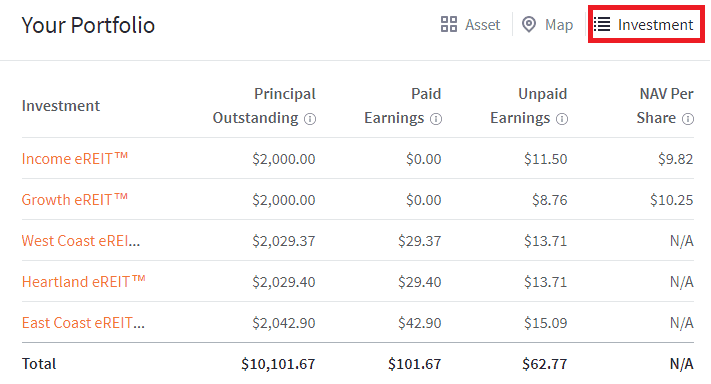
Fundrise vs REIT
In recent years, crowdfunding platforms have made it possible for investors to invest in private real estate deals without requiring a large initial investment. These investments can provide you with a stream of income from rental payments and diversify your portfolio.
Fundrise can be a good investment for anyone, even if you're a novice investor. You need to determine how much you are willing and able to risk, as well as what type of return you would like to see.
The next step is determining if a Reit is the right investment for you. While reits are similar to stocks in terms of returns, they can also be volatile. These investments also charge higher fees than most other types of investment, which can have a negative effect on your returns.
REITs versus eREITs
A REIT, or real estate investment trust (REIT), is a non-listed public entity that pools funds to purchase and manage commercial properties. This generates income for investors via rental payments. This type is best for investors looking to invest over the long term and see a steady return on their investment.

This type of investment, however, may not suit younger or more cautious investors as it is volatile and hard to predict the future. Furthermore, REITs often require a higher risk than other investment options, such as bonds and equities.
If you're interested in investing in real estate, a REIT is a good option for you. REITs allow you to invest in the equity of real estate companies. You can use them to buy different types properties, such as shopping malls, office buildings, hotels and residential complexes.
A second advantage of REITs, is that they offer a tax-efficient alternative to other property investments. REITs distribute a dividend that is not taxed as income to investors.
When REITs sell property, they also pay capital gain. These gains will be added to your tax returns, but are not ordinary income. This is because you received the money from the sale from your own money.
Jhangiani says that you should take into consideration the REIT's management, fee structure and strategy as well as its leverage over assets. In addition, you should ask for information on how the company handles cash-flows and debt repayment.

You should also consider the fees and commissions charged by your broker or financial advisor. Shop around as these fees can be expensive.
Fundrise lets you buy shares in several eREITs, depending on your objectives. You can choose between income-oriented and growth-oriented eREITs. Each has its own objectives, which you can read about on the website. The company offers a variety of portfolios based upon goals, which include up 7 eREITs each with their unique set of properties.
FAQ
How do I choose an investment company that is good?
It is important to find one that charges low fees, provides high-quality administration, and offers a diverse portfolio. Fees vary depending on what security you have in your account. Some companies charge no fees for holding cash and others charge a flat fee per year regardless of the amount you deposit. Others may charge a percentage or your entire assets.
You should also find out what kind of performance history they have. A company with a poor track record may not be suitable for your needs. Avoid companies that have low net asset valuation (NAV) or high volatility NAVs.
Finally, it is important to review their investment philosophy. An investment company should be willing to take risks in order to achieve higher returns. If they aren't willing to take risk, they may not meet your expectations.
Why are marketable securities important?
An investment company's main goal is to generate income through investments. It does this by investing its assets in various types of financial instruments such as stocks, bonds, and other securities. These securities offer investors attractive characteristics. These securities may be considered safe as they are backed fully by the faith and credit of their issuer. They pay dividends, interest or both and offer growth potential and/or tax advantages.
What security is considered "marketable" is the most important characteristic. This is the ease at which the security can traded on the stock trade. A broker charges a commission to purchase securities that are not marketable. Securities cannot be purchased and sold free of charge.
Marketable securities can be government or corporate bonds, preferred and common stocks as well as convertible debentures, convertible and ordinary debentures, unit and real estate trusts, money markets funds and exchange traded funds.
Investment companies invest in these securities because they believe they will generate higher profits than if they invested in more risky securities like equities (shares).
What are the benefits to owning stocks
Stocks are more volatile that bonds. Stocks will lose a lot of value if a company goes bankrupt.
The share price can rise if a company expands.
To raise capital, companies often issue new shares. Investors can then purchase more shares of the company.
To borrow money, companies use debt financing. This allows them to access cheap credit which allows them to grow quicker.
A company that makes a good product is more likely to be bought by people. Stock prices rise with increased demand.
Stock prices should rise as long as the company produces products people want.
How are securities traded
The stock exchange is a place where investors can buy shares of companies in return for money. Investors can purchase shares of companies to raise capital. Investors can then sell these shares back at the company if they feel the company is worth something.
The price at which stocks trade on the open market is determined by supply and demand. The price of stocks goes up if there are less buyers than sellers. Conversely, if there are more sellers than buyers, prices will fall.
There are two options for trading stocks.
-
Directly from the company
-
Through a broker
What is security in a stock?
Security is an investment instrument whose worth depends on another company. It can be issued as a share, bond, or other investment instrument. If the underlying asset loses its value, the issuer may promise to pay dividends to shareholders or repay creditors' debt obligations.
Statistics
- US resident who opens a new IBKR Pro individual or joint account receives a 0.25% rate reduction on margin loans. (nerdwallet.com)
- "If all of your money's in one stock, you could potentially lose 50% of it overnight," Moore says. (nerdwallet.com)
- Even if you find talent for trading stocks, allocating more than 10% of your portfolio to an individual stock can expose your savings to too much volatility. (nerdwallet.com)
- The S&P 500 has grown about 10.5% per year since its establishment in the 1920s. (investopedia.com)
External Links
How To
How to create a trading plan
A trading plan helps you manage your money effectively. It helps you understand your financial situation and goals.
Before you begin a trading account, you need to think about your goals. You may want to make more money, earn more interest, or save money. If you're saving money you might choose to invest in bonds and shares. If you are earning interest, you might put some in a savings or buy a property. If you are looking to spend less, you might be tempted to take a vacation or purchase something for yourself.
Once you know what you want to do with your money, you'll need to work out how much you have to start with. This will depend on where and how much you have to start with. You also need to consider how much you earn every month (or week). Your income is the net amount of money you make after paying taxes.
Next, you need to make sure that you have enough money to cover your expenses. These include rent, bills, food, travel expenses, and everything else that you might need to pay. These all add up to your monthly expense.
You will need to calculate how much money you have left at the end each month. This is your net income.
This information will help you make smarter decisions about how you spend your money.
Download one from the internet and you can get started with a simple trading plan. Ask an investor to teach you how to create one.
Here's an example: This simple spreadsheet can be opened in Microsoft Excel.
This graph shows your total income and expenditures so far. You will notice that this includes your current balance in the bank and your investment portfolio.
And here's another example. This was designed by a financial professional.
This calculator will show you how to determine the risk you are willing to take.
Remember, you can't predict the future. Instead, you should be focusing on how to use your money today.